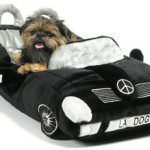Is Fido the Next Ideal Target Audience Member? A look at brands that have extended into the world of pet products

Brand extensions are a common way for established brands to profit from untapped markets that their current product line does not appeal to. By entering into an entirely different product category, these brands can attain these customers and, if done correctly, the extension can be a very lucrative endeavor. For example, Ralph Lauren’s Polo brand successfully extended from a clothing line to home furnishings, such as linens and towels, and beyond. But if a brand extension fails, the parent brand runs the risk of diluting or damaging its brand image and equity.
So why would a well-known brand enter into an entirely unrelated product category, such as pet products? In an interview with Extendonomics, Maria Peevey, CEO and Creative Director of SimplyShe, a leader in the pet lifestyle category, said, “Pet parents increasingly want the same treatment options for their pets as they have for themselves.” These “pet parents”, not pet owners, will go beyond the basic pet needs such as kibble and vet visits and strive to pamper their pets. Brands, such as Martha Stewart, have extended into this category in order to reach these pet-centric customers and provide them with products that allow them to share everyday human luxuries with their pets. Now you can sit on your Martha Stewart couch and read your Martha Stewart Magazine while your pooch lounges on his Martha Stewart dog bed.
When brands consider making the leap into a new category, they must decide if the move is a good match for their brand’s mission and goals. For luxury salon brand Paul Mitchell, moving from human hair care to pet shampoos seemed like a natural extension. This belief brought to life John Paul Pet, a company dedicated to providing “pet care with a salon pedigree.” While there are mixed reviews about the success of this brand extension, with some critics stating that this decision significantly eroded the luxury salon brand, others argue that if pet parents want their dog, cat of even horse to use these high-quality, pH balanced products, then they should have the option. Both brands have banned animal testing on their product lines and John Paul Pet supports non-profit organizations including The Humane Society of the United States and the Best Friends Animal Society.
Another well-known human luxury brand, Omaha Steaks, has ventured into the world of pet products and now offers Omaha Steaks Pet Treats. These cat and dog treats are made from genuine USDA meats and often require refrigeration after opening, a fact that may cause some confusion among pet parents who are looking for some steaks to grill. In her interview, Peevy noted that it is easy for brands to transition into the pet market because they can use excess materials to make the products- leftover fabrics are used to make pet clothes, unused leather from a belt makes a great dog collar and meat that wouldn’t live up to a human’s expectation from Omaha Steaks can be made into a yummy dog treat.
Successful pet brand extension companies all have one thing in common- they know they are selling to humans. These pet parents want their companions to have the same things they love, whether that’s clothes, furniture or grooming products. Tell us what you think of these brand extensions in the comments below.
Mixed by Lily Brock
Introducing Dr. Doggie

......................................................................................................................................................................
Apparently man’s best friend is taking on a whole new meaning…lifesavers! I’m not talking about Lassie, seeing eye dogs, or Newfoundland rescue dogs. I’m talking about trained “health care professionals.”
About five years ago, research began as an investigation done by an orthopedic surgeon, Dr. John Hunt. He was curious about numerous reports of dogs pestering their owners repeatedly on parts of their bodies that were later found to be cancerous. Hunt’s research showed that dogs’ hypersensitive noses are capable of detecting cancer cells and abnormalities in humans. Recently, the case of Paul Jackson, who suffers from diabetes, revealed that dogs can also warn their owners when their sugar levels get too low.
These findings led to British dogs specifically being trained to sniff out certain health dangers in humans at the Cancer and Bio-Detection Dogs research centre in Aylesburg, England. This Reuters article offers great insight on the details of how dogs are capable of having this innate skill.
So, is this the beginning of a new means for patient diagnosis? It may not be practical to have a dog in every doctor’s office, but researchers are attempting to invent an electronic nose that will be capable of mimicking this ability. The device is currently said to be about 15 years behind. Either way, these findings definitely prove that man’s best friend offers much more than companionship.
Contributed by: Ashley Hollingsworth
Myth Busters: Dogs & Their Owners
Every heard of the saying that a dog looks like its owner? Let's test this old wives tale. Please match the Addison Whitney employee with his/her dog!


![]()
Wanna see the matchups? Click here.
By: Trista Thielker
Taco Terrier
While I was on the verge of purchasing a puppy it got me thinking about puppy names. I could go with the standard cool name like Bruiser, to the more traditional name like Baxter, to the type of breed. Each breed of dog has its own characteristics, attributes and benefits, similar to that of a brand. Now, a dog that was once considered just a cute mutt has transitioned into its very own brand category … a “designer breed”, which has me completely baffled. Just to give you an idea of how many of “designer breeds” exist, I compiled a list of registered names from the ACHC.
- Yorkshire Terrier + Poddle = YorkiePoo
- Jack Russell Terrier + Poodle = Jack-A-Poo
- Labrador Retriever = Labrodoodle
- Chihuahua + Dachshund = Chiwinie
- Poodle + Westie = Wee-Poo
- Bulldog + Pug = Buggs
- Pomeranien + Poddle = PomaPoo
- Affenpinscher + Chihuahua = Affenhuahua
- Affenpinscher + Poddle = Affenpoo
- American Bulldog + Boxer = Bulloxer
- American Bulldog + Mastif = MastiBull
- Alaskan Malamute + Siberian Husky = Alusky
- American Eskimo + Cocker Spaniel = Cock-A-Mo
- American Eskimo + Shih Tzu = Shih-Mo
- American Rat Terrier + Boston Terrier = Brat
- Beagle + Jack Russell Terrier = Jack-A-Bee
And two of my personal favorites…
- Basset Hound + Miniature Schnauzer = Bowzer
- Chihuahua + Toy Fox Terrier = Taco Terrier
…believe me the list goes on and on
Moreover, I have noticed that in the corporate world, the “breeding” of two brand names often takes a more conservative approach to naming.
MillerCoors (perhaps “Cooller” possibly could of work due to the environment in which their product lives).
Thomson Reuters (Reuterson ehh maybe that is just a bad last name, ie Tom Reuterson).
Is this good "brandalosophy"? Or should a new name be developed opening the door to refined characteristics and benefits giving birth to a new “designer brand?”
By: Nick Irwin
Dog-Gone Marketing

......................................................................................................................................................................
Man’s best friend has become a marketer’s dream. It’s no longer simply designer carriers and rhinestone-studded leashes. Today’s pups are surrounded by as many luxury labels and fashion trends as the rest of us. With clever brand names to boot.
Read more
